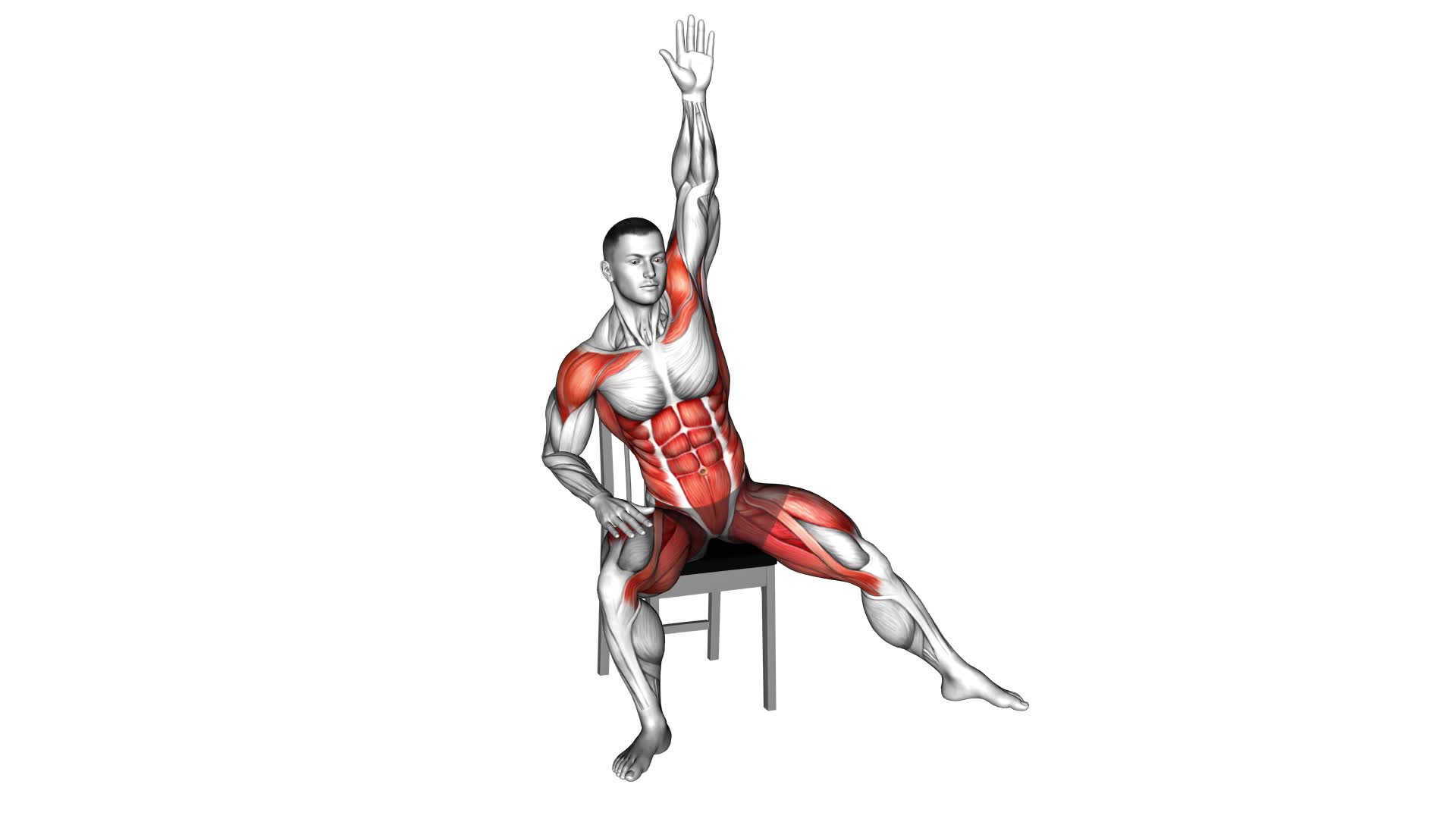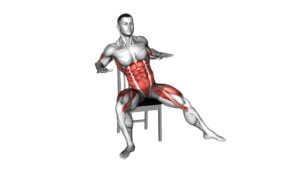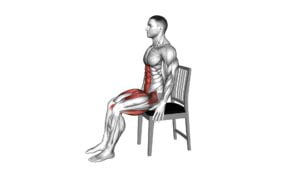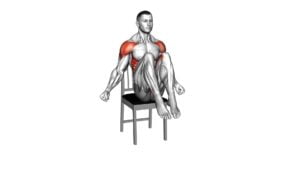Sitting Side Step on Chair (male) – Video Exercise Guide & Tips

Are you looking for an effective exercise to strengthen your lower body? Look no further than the Sitting Side Step on Chair.
Watch This Exercise Video
In this video exercise guide, you'll learn the proper form and technique to perform this exercise correctly. With variations and modifications available, you can tailor this workout to your fitness level.
Avoid common mistakes and discover tips for progression and challenges. Get ready to elevate your leg strength and balance with this dynamic exercise.
Key Takeaways
- The sitting side step on a chair strengthens lower body muscles such as quadriceps, hamstrings, and glutes.
- It improves balance and stability.
- The exercise is suitable for individuals with limited mobility or difficulty with weight-bearing exercises.
- It provides a seated workout targeting multiple muscle groups.
Benefits of the Sitting Side Step
You can experience numerous benefits by incorporating the Sitting Side Step into your exercise routine. This chair exercise provides a seated workout that targets multiple muscle groups and improves your overall fitness.
One of the key benefits of the Sitting Side Step is its ability to strengthen your lower body. As you perform the side steps, you engage your quadriceps, hamstrings, and glutes, helping to tone and strengthen these muscles. This is especially beneficial for individuals who may have difficulty with weight-bearing exercises or have limited mobility.
Additionally, the Sitting Side Step can improve your balance and stability. By shifting your weight from side to side, you challenge your body to maintain its equilibrium. This can be particularly beneficial for older adults or individuals recovering from injuries, as it helps to reduce the risk of falls and improve overall stability.
Furthermore, this seated workout can also improve your cardiovascular endurance. By performing the side steps at a moderate to high intensity, you can elevate your heart rate and increase blood flow, providing a cardiovascular workout while seated.
Incorporating the Sitting Side Step into your exercise routine can provide numerous benefits, including strengthening your lower body, improving balance and stability, and increasing cardiovascular endurance. So why not give it a try and start reaping these benefits today?
Proper Form and Technique
To execute the Sitting Side Step on a chair properly, position yourself with your feet hip-width apart. Maintaining proper form and technique is crucial for the effectiveness of this exercise and to avoid any potential injuries. Here are some important points to keep in mind:
- Engage your core muscles throughout the exercise to stabilize your body.
- Keep your back straight and your shoulders relaxed.
- Bend your knees slightly and lower your body down onto the chair, ensuring that your weight is evenly distributed.
- Step to the side with one foot, followed by the other, maintaining a controlled and steady pace.
- As you step, avoid letting your knees collapse inward or outward and maintain proper alignment.
Proper technique is essential to get the most out of the Sitting Side Step exercise while minimizing the risk of injury. By following these guidelines, you can ensure that you're targeting the correct muscles and maintaining good posture throughout the movement. Remember to listen to your body and adjust the exercise as needed to prevent any discomfort or strain.
Chair Selection and Setup
Choose the appropriate chair for the Sitting Side Step exercise to ensure comfort and stability. When selecting a chair for this exercise, opt for an ergonomic chair that provides proper support and promotes good posture. An ergonomic chair will have adjustable features such as a backrest, armrests, and seat height, allowing you to customize it to your body's needs. This will help prevent any strain or discomfort during the exercise.
To set up the chair properly, start by adjusting the chair height. Your feet should be flat on the floor, with your knees bent at a 90-degree angle. This position will provide stability and support while performing the Sitting Side Step exercise. Make sure the chair is stable and doesn't wobble, as this can lead to accidents or injuries.
Variations and Modifications
Explore different ways to modify and vary the Sitting Side Step exercise on a chair for a more challenging or customized workout. Here are some progression modifications and advanced variations to consider:
- Increase the height of the chair: Try performing the exercise on a higher chair or add an elevated platform to make it more challenging for your legs and glutes.
- Add resistance: Incorporate ankle weights or use resistance bands around your thighs to increase the difficulty and target your muscles even more.
- Single-leg variation: Instead of using both legs to perform the side step, try doing it with just one leg. This will engage your stabilizer muscles and enhance balance and coordination.
- Speed it up: Increase the tempo of the exercise by performing the side steps at a faster pace. This will elevate your heart rate and add a cardiovascular component to the workout.
- Combine with other exercises: Incorporate the Sitting Side Step into a circuit or superset with other lower body exercises like squats or lunges to create a more comprehensive and challenging workout.
Common Mistakes to Avoid
When performing the sitting side step on a chair exercise, it's crucial to pay attention to proper form.
Many people make technique errors, such as leaning too far forward or using momentum to complete the movement.
These mistakes can't only compromise the effectiveness of the exercise, but also increase the risk of injury.
To avoid these issues, focus on maintaining a straight back, engaging your core, and using controlled movements throughout the exercise.
Proper Form Importance
Maintain proper form during the Sitting Side Step on Chair exercise to maximize effectiveness and prevent common mistakes. The importance of proper technique can't be overstated, as it ensures that you target the correct muscles and reduce the risk of injury.
Here are some tips for maintaining proper form:
- Keep your back straight throughout the exercise to engage your core muscles.
- Place your feet hip-width apart on the chair, with your toes pointed forward.
- Bend your knees and lower your body into a squat position, making sure your knees don't extend past your toes.
- As you step to the side, keep your weight evenly distributed and your knees aligned with your toes.
- Engage your glutes and push through your heels to return to the starting position.
Remember to focus on maintaining proper form to get the most out of the Sitting Side Step on Chair exercise.
Common Technique Errors
To avoid common technique errors in the Sitting Side Step on Chair exercise, it's important that you pay attention to your form and make necessary adjustments. Common technique errors can lead to injuries, so it's crucial to be aware of them and take steps to prevent them.
One common mistake to avoid is leaning too far forward or backward while performing the exercise. This can put strain on your lower back and increase the risk of injury.
Another common error isn't fully extending your legs while stepping onto the chair. This can lead to imbalances and place unnecessary stress on your joints.
Injury Prevention Tips
To prevent injuries and avoid common mistakes, focus on maintaining proper form and making necessary adjustments while performing the Sitting Side Step on Chair exercise.
Here are some injury prevention techniques to keep in mind:
- Warm up properly before starting the exercise to prepare your muscles and joints.
- Engage your core muscles throughout the exercise to provide stability and support.
- Keep your back straight and avoid rounding your shoulders to maintain proper posture.
- Use a sturdy chair with a stable base to prevent falls or accidents.
- Start with small, controlled movements and gradually increase the range of motion as you become more comfortable and confident.
By following these injury prevention tips, you can reduce the risk of accidents or strains while performing the Sitting Side Step on Chair exercise.
Remember to listen to your body and stop if you experience any pain or discomfort.
Tips for Progression and Challenges
To progress in the sitting side step on a chair exercise, there are several tips you can follow.
First, you can increase the difficulty level by adding resistance bands or weights.
Additionally, you can try variations such as performing the exercise on an unstable surface or incorporating a balance challenge.
Remember to progress safely and effectively by listening to your body and gradually increasing the intensity as you become stronger.
Increasing Difficulty Levels
To increase the difficulty level of the Sitting Side Step on Chair exercise, try incorporating additional resistance or adding an unstable surface. Here are some progression techniques and advanced modifications to challenge yourself further:
- Use resistance bands: Attach resistance bands around your ankles or knees to increase the workload on your leg muscles.
- Hold dumbbells: Add dumbbells to your hands while performing the exercise to increase upper body resistance and overall difficulty.
- Try a balance disc: Place a balance disc or wobble cushion on the chair to create an unstable surface, forcing your core and leg muscles to work harder for stability.
- Use a higher step: Increase the height of the step or use a platform to make the exercise more challenging and engage your leg muscles even more.
- Incorporate plyometric movements: Instead of simply stepping on and off the chair, add explosive jumps or hops to increase the intensity and challenge your cardiovascular fitness.
Variations for Added Challenge
Increase the difficulty of the Sitting Side Step on Chair exercise by incorporating these variations for added challenge.
To increase intensity, try using ankle weights or holding dumbbells in your hands while performing the exercise. This will add resistance and engage your muscles even more.
Another advanced modification is to perform the exercise on an unstable surface, such as a balance board or a foam pad. This will challenge your balance and stability, forcing your muscles to work harder.
You can also try increasing the speed of your side steps, making sure to maintain proper form and control.
Remember to always listen to your body and progress at your own pace.
These advanced modifications will help you take your Sitting Side Step on Chair exercise to the next level.
Progressing Safely and Effectively
As you progress safely and effectively in your Sitting Side Step on Chair exercise, it's important to incorporate tips for progression and challenges to continue pushing your muscles and improving your stability and balance.
Here are some safety precautions and effective exercises to consider:
- Gradually increase the height of the chair to challenge your balance and strength.
- Introduce resistance bands to add resistance and engage your muscles further.
- Try performing the exercise on an unstable surface, such as a balance pad or foam mat, to work on your stability.
- Incorporate lateral leg lifts or knee raises while sitting on the chair to target different muscle groups.
- Experiment with different tempos and repetitions to vary the intensity of the exercise.
Remember to listen to your body and progress at a pace that feels comfortable for you. Always prioritize safety and consult with a healthcare professional before starting any new exercise program.
Frequently Asked Questions
How Long Should I Hold the Sitting Side Step Position on Each Side?
When performing the sitting side step exercise, it's important to hold the position on each side for an adequate amount of time. It's recommended to hold the position for about 10-15 seconds on each side.
However, the duration can be adjusted based on your comfort level and fitness level.
If you have limited mobility, you can modify the exercise by reducing the range of motion or using a chair with armrests for support.
Can the Sitting Side Step Exercise Help With Improving Balance?
The sitting side step exercise can definitely help improve your balance. By engaging in this exercise regularly, you'll be able to enhance your coordination and strengthen your leg muscles.
This exercise involves side stepping while sitting on a chair, which challenges your stability and forces you to use your core muscles. By practicing this exercise, you'll develop better balance and stability, ultimately improving your overall physical fitness.
Is It Necessary to Warm up Before Performing the Sitting Side Step Exercise?
It's important to warm up before performing the sitting side step exercise.
Dynamic warm up exercises help to increase blood flow, warm up the muscles, and prepare your body for physical activity. This can help prevent injuries and improve your performance.
If you're looking for alternatives to traditional warm up routines, you can try activities like jogging in place, jumping jacks, or even a brisk walk. Just make sure to get your body moving and your heart rate up before starting the exercise.
Can the Sitting Side Step Exercise Be Modified for Individuals With Limited Mobility?
Yes, the sitting side step exercise can be modified for individuals with limited mobility. Modified variations, such as using a lower chair or performing smaller steps, can make it more accessible.
This exercise has many benefits for seniors, including improving balance, strengthening the lower body, and increasing flexibility.
It's important to consult with a healthcare professional or fitness instructor to ensure proper modifications and technique.
Are There Any Specific Breathing Techniques That Should Be Followed During the Sitting Side Step Exercise?
During the sitting side step exercise, it's important to focus on your breathing.
Take deep breaths in and exhale as you step to the side.
This helps to engage your core muscles and maintain stability throughout the movement.
By incorporating proper breathing techniques, you can enhance the benefits of this exercise on your core strength.
Conclusion
In conclusion, the sitting side step on a chair is a beneficial exercise for strengthening the lower body muscles.
By following proper form and technique, selecting the right chair and setup, and making variations and modifications, you can maximize the effectiveness of this exercise.
Avoiding common mistakes and gradually progressing will help you achieve your fitness goals.
Incorporating the sitting side step into your workout routine can provide a challenging and rewarding workout experience.

Author
Years ago, the spark of my life’s passion ignited in my mind the moment I stepped into the local gym for the first time. The inaugural bead of perspiration, the initial endeavor, the very first surge of endorphins, and a sense of pride that washed over me post-workout marked the beginning of my deep-seated interest in strength sports, fitness, and sports nutrition. This very curiosity blossomed rapidly into a profound fascination, propelling me to earn a Master’s degree in Physical Education from the Academy of Physical Education in Krakow, followed by a Sports Manager diploma from the Jagiellonian University. My journey of growth led me to gain more specialized qualifications, such as being a certified personal trainer with a focus on sports dietetics, a lifeguard, and an instructor for wellness and corrective gymnastics. Theoretical knowledge paired seamlessly with practical experience, reinforcing my belief that the transformation of individuals under my guidance was also a reflection of my personal growth. This belief holds true even today. Each day, I strive to push the boundaries and explore new realms. These realms gently elevate me to greater heights. The unique combination of passion for my field and the continuous quest for growth fuels my drive to break new ground.







